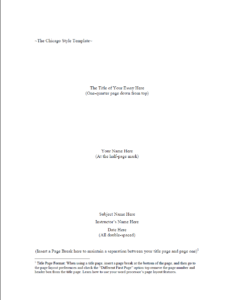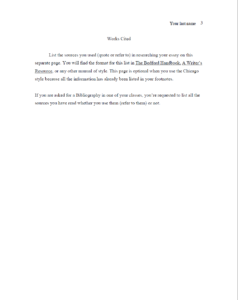Toll-Free US & Canada 24/7:
1-770-659-7014
As a precautionary health measure for our support specialists in light of COVID-19, our phone support option will be temporarily unavailable. However, orders are processed online as usual and communication via live chat, messenger, and email is conducted 24/7. There are no delays with processing new and current orders.
Chicago Style Paper Example
Are you interested in knowing everything about a Chicago citation and formatting style? Or perhaps you are just looking for an answer to the question: “What is a Chicago style paper?”
We will be glad to help you out and show you where to find an example of Chicago style paper, as well as where to get help on Chicago style in general. This 3-minute read article holds all the answers.
Chicago style paper format vs. Turabian Style
Chicago paper style is a classic example of American English formatting and citation. It was originally developed at the beginning of the 20th century in Chicago to regulate the professional publishing business of educational and journal companies and institutions. Initially, it was widely used by book publishers and the academic society in general.
Later, however, it became extremely popular across the US and abroad as a formatting and referencing style of choice for academic use in Humanities and Social Studies. It’s not rare when this style is applied by Fine Arts, History, and even Business practitioners.
Interestingly, half a century later (in the 1950s), the Chicago style got a major “upgrade” in the form of a simplified formatting and referencing style called Turabian. It was named after Kate Turabian, who worked as a dissertation works secretary at the University of Chicago for over 25 years!
Sure enough, during this long time, she observed thousands of students struggling with the overly complicated Chicago style, and she decided to simplify it. The result was a new style called after its creator, which is intended for students of the Humanities, who are NOT going to publish their works.
Writing a paper in Chicago style
A Chicago style is all about simplicity and making it easy for students and faculty members. Perhaps, that’s the major reason why it is so widely used not only by students of Social Studies and Humanities but also by students of many other disciplines, including natural sciences and business.
The core rules of the Chicago style stipulate the following:
- Using the Times New Roman font style by default;
- A middle-size font size, most often size 12 or 14;
- Ensure at least 1-inch margins on all sides of your text;
- Starting each paragraph with ½ inch indent;
- Include page numbers at the bottom center (sometimes also be found in the upper right corner).
A typical Chicago style paper template doesn’t require a title page (remember – simplicity is the number one rule). However, should your specific instructor’s requirements override the default Chicago style, you may need to include a title page. In that case, you must make it in the same font style and size as the main text. Also, your title should be center-aligned and use double-spacing between the lines.
Chicago style paper body
We strongly recommend writing any central part of your paper only once you have made a good outline. The Chicago style paper outline is the same format-wise as any other paper style. However, there are three important requirements for the body of any Chicago-style paper:
- The main text should be double-spaced;
- The text should be aligned on the left side (consequently, the right-side margin would look uneven);
- Should your paper require subheadings, you must present them in a different font. E.g., use bold font style for the title and headings, while ordinary or italics for subheadings.
Footnotes and endnotes are also regulated in Chicago style (same as with Turabian). The Chicago style paper footnotes, for example, should appear right after the relevant sentence, and be separated from it by a comma. The Chicago style paper endnotes come as a separate list at the end of a paper.
The Chicago style stipulates two different citation types: in-text citations and a bibliography list at the end of the text.
- The in-text citations are formatted in the author-date style. You should use such citations inside the text separated by parentheses. For example: (Smith 2019). Notice that there is no comma between the author and the year of publication.
- The end-of-the-text bibliographic list utilizes complete information about cited sources, including the author’s first and second names, year of publication, the title of the work, and references pages if applicable.
Help with sample of Chicago style paper
At Bookwormlab.com we can quickly help you out with your Chicago style paper, including the Chicago style paper title page or Chicago style paper header. Students come to us with various requests on this topic, starting with a short consultation on the correct citing rules to writing an advanced academic paper using the Chicago style. We take pride in our reputation as a reliable and trustworthy academic partner for students and business customers.
We don’t require your real contact information or the name of your academic institution. The core principle of our business is keeping our clients happy and satisfied by providing high-quality writing services and keeping our clients’ personal information strictly confidential.
Place your order today to make use of the summer discounts. We don’t charge our clients for the title page and will be happy to provide our registered users with a Chicago style paper sample also free of charge!


